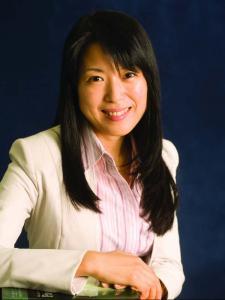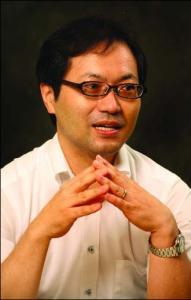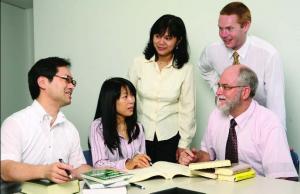Trademark Law in Japan
Kazuko Fujita and lessons for trademark registration in Japan
By Joseph Greenberg
 Kazuko Fujita
Kazuko Fujita
The Balancing Act: Kazuko Fujita
Kazuko Fujita is founder and director of the LIL (Legal Interface Liaison) International Patent & Trademark Firm, responsible for an office of 30 staff, a fully qualified benrishi (Japanese patent attorney), a wife and a mother of two children. Much is written in Japan about the young generation of dynamic, ambitious women who choose to have a career over a traditional family role. Ms Fujita appears to have chosen both. When asked about how she has managed to balance her work and family life, she responded that, “It is vital to separate the two. You can’t focus properly on your children while you are thinking about work, and the same is true the other way—it’s safest to divide your time carefully and give each the necessary amount of attention.” Undoubtedly this is a case of ‘much easier said than done’ but she is adamant that making a double commitment to both career and family is both a realistic and very rewarding goal.
Having always shown academic ability, Fujita won a place at Seikei University, one of Japan’s top academic institutions. Its alumni include former President of the Japan Bar Association, Go Kajitani, and several famous novelists. Graduating from the Faculty of Economics & Management, Fujita showed a strong aptitude for marketing and then sailed into her first job at the Tokyu Agency, one of Japan’s most powerful marketing and advertising agencies. However, having always had an interest in intellectual property (IP), in 1994 she embarked on a career as a benrishi working at a patent firm in Tokyo. In total there are 7,264 benrishi in Japan of which only 842 are women. Fujita has a wide knowledge and experience of IP law and her firm has put a great deal of effort into handling trademark issues.
Understanding trademark law in Japan
As with most aspects of modern Japanese law, the origins of Japan’s trademark laws can be traced to the Meiji period when Japanese legal experts studied European law extensively and ended up passing Japan’s first trademark law in 1884— based largely upon the German law enacted a decade earlier. However, even before that, in 1860 the Tokugawa shogunate sent over 75 scholars to the US to study intellectual property and in his book Japanese Trademark Jurisprudence, Kenneth Port argues that there was a rudimentary trademark system in existence throughout the Tokugawa period (1603-1868). Like so many of life’s complications, the trademark system apparently started with a drink. Port claims that as sake brewers started to evolve into companies that marketed and sold their products beyond their immediate local vicinity, they began to use symbols in order to prevent confusion among customers, and plagiarism from rivals. Throughout the Meiji period however, the laws for the protection of IP in Japan were gradually brought into line with those of Europe and the US.
 Fumihiko Yagisawa: partner at LIL
Fumihiko Yagisawa: partner at LIL
According to Fujita’s partner at LIL, Fumihiko Yagisawa, a fellow benrishi, “foreign corporations do not have a sufficient understanding of trademark law in Japan. Many foreign companies in Japan don’t realize that the TM mark granted by the authorities in the US does not register them globally.” It is thus necessary to make an application in Japan regardless of whether TM status has been attained. Failure to register a trademark through the Japanese system could leave companies open to accusations of infringement should a Japanese organization beat them past the post. It might also force them to change their established brand name solely for the Japanese market— an action that could be damaging for business given the Japanese consumers’ preference for brand heritage. In registering trademarks in Japan, according to Yagisawa and Fujita, there are three major difficulties to overcome.
1. The language barrier
Applications must be submitted using a special form of Japanese. The format does not need to be as detailed as required by the authorities in the US but the overview must be written according to Japanese convention. Beyond this, so-called ‘Japanese English’ can be very confusing for both the party making the application and the trademark examiners. For example, in Japan the word ‘Y-shirt’ is used for a white business shirt while the Japanese refer to a food blender as a ‘mixer.’
2. Concepts
It is difficult to make applications for products not yet in existence. For example, farming machinery that is common in Australia but not known in Japan is extremely difficult to describe to trademark examiners in Japan. This requires not only knowledge and experience of legal language but also a technical understanding of the product.
3. The examination process
In many countries such as the US, the outcome of applications is predictable. In Japan, the triangle of communication between the client, attorney and examiner can be as important to an application’s success as the legal framework. The patent attorney is thus forced to transpose viewpoints in terms that can be understood on either side.
Both Yagisawa and Fujita have experience with these problems and LIL has put a number of measures in place to tackle the issues. Because both points 1 and 3 above relate to issues of communication, LIL have created a translation capacity of foreign and Japanese multilinguals who also have either technical or trademark law experience, and often both (see translation information box). In dealing with foreign clients, Yagisawa stresses that “in contrast to other Japanese patent firms that basically tend to correspond via email and letters, LIL prefer direct follow-up with clients by either telephone conferencing or in person, as well as using native speakers to enhance the quality of communication.” Making regular trips overseas to visit clients, LIL stay in tune with client expectations and linguistic nuances as well as being able build up its international network from Russia to Saudi Arabia and from the US to Italy.
 Multilingual & multicultural: the LIL translation team in discussion with Fujita and Yagisawa
Multilingual & multicultural: the LIL translation team in discussion with Fujita and Yagisawa
In addition to the above difficulties, Fujita told us that there is no consent system concerning trademark usage in Japan—in many countries a trademark can be registered even if there is a similar one in use, if consent can be gained from the other party due to there being enough difference in the product or service in question for there to be an absence of confusion. For example, Apple, The Beatles recording label in Abbey Road gave consent to Apple, the Macintosh computer manufacturer, to use the name for their computer business as there was no apparent conflict of interest—with the advent of iTunes and the iPod this has changed and become a notorious source of friction between the two.
In theory, in Japan such an issue could not arise because the nature of the business isn’t considered in the application process, only in name. However, Michiru Takahashi, a Japanese trademark law expert from Jones Day says that in practice, “practitioners take a roundabout method…[they] transfer the pending application to the owner of the cited mark, and then the mark is transferred back to them once it is registered.” A convoluted system indeed, but one wonders if in today’s world of boundless brand extension it might help prevent more headaches than it creates.
Translation: How it works
In-house translator David Long at LIL spoke to us about the translation process involved in international patent and trademark applications.
LIL employs a team of around 15 inhouse translators half of whom are foreigners, and then has another 70 or so outsourced translators. They are not only bilingual and bicultural but have a vast experience of intellectual property law and patents, and many of them have a third or fourth language. As Long told us, getting the translation right is a fundamental part of the process and “a large number of rejections are often down to a technicality in the translation.” It is particularly hard with jargon words and LIL’s team has had to master another language that Long terms ‘patentese.’
 David G Long: Translator/Interpreter, LIL International Patent & Trademark Firm
David G Long: Translator/Interpreter, LIL International Patent & Trademark Firm
Long also told us that, “unlike other patent & trademark offices, we also have native translation-checkers in key locations in North America—for example, Hawaii, West Coast, East Coast—to keep up with the demand of proofreading in other time zones in order to achieve speedy service for our clients.”
In applying for patents, the product or invention description is of necessity a highly detailed document and the skill in translation involves the avoidance of ambiguity and razor sharp precision of vocabulary. There are a number of computer programs that can help in the early stages of the process but ultimately the final draft is in the hands of a human. Even with such experts on the team, LIL leaves little to chance and employs a triple-check system by which the translated document goes back and forth between bilingual proofreaders three times.
Among the interesting errors that Long has picked up, he recalls a patent application bound for China that requested the company to “kindly wait until the examiner had been executed,” rather than the examination executed.
IP protection for small-medium enterprises
In particular, Ms Fujita has experienced that foreign small-medium enterprises (SMEs) have difficulties understanding the Japanese system because they don’t have the advisers and experience. Having written a book on protecting IP for SMEs (Judicial Business: Practical Defense of Brand Names for Small-Medium Enterprises) she is also sympathetic to the needs and difficulties of such businesses. For foreign SMEs she says that one of the main difficulties is realizing that “while in the US, the original inventor is considered to be the rightful owner of the patent, in Japan, the right belongs to the first to file a successful application—regardless of the timing of the original invention.” This often leads to differences in expectation that can be particularly difficult for smaller companies who tend to be much more dependent on only one or a handful of inventions.
“While in the US, the original inventor is considered to be the rightful owner of the patent, in Japan, the right belongs to the first to file a successful application — regardless of the timing of the original invention”
However, contextual differences aside, Fujita thinks that the greatest problem for SMEs is confidentiality, “either an employee lets slip the idea to a friend or the marketing starts too early and the media publicize a new invention or product before the application has gone through.” Before they know it, a larger competitor is able to get everything up and running first and thus gets through the patent or trademark application process faster. It sounds obvious, but knowing when to let the cat out of the bag can be a very hard learned lesson if you don’t know every nook and cranny of the law. In Japan the ‘pro-patent’ culture is a new development and inventors are still often inclined to wait until they are able to produce a complete product as opposed to getting in there and protecting the idea.
LIL are unique in that they actually employ a team of designers that can facilitate trademark registration from the formulation phase. While other firms may have staff capable of providing text, LIL is able to create logo designs, thus deepening their support services available for those entering the market for the first time or under a new name. For larger clients this facility is also useful if the logo needs special adaptation for Japan.
The road ahead
To employ CPA and MBA holders, specialists in law, translation experts and even designers, is a large personnel investment. However, LIL is confident that this is essentially a non-risk venture as it places them ahead of the game in terms of trademark registration, and indeed in other areas of their practice such as copyright or antitrust law.
For the future, Kazuko Fujita intends to recruit more bilinguals and maintain LIL’s already rigorous translation capacity. She also sees the need to keep on top of international IP developments and does so by attending events held by worldwide associations such as at the Federation Internationale des Conseils en Propriété Industrielle (FICPI) in France. Ms Fujita anticipates an increase in the implementation of international IP standards and hopes to build on the company’s already established reputation as a bridge between international and Japanese IP legislation.
Contact details
President: Kazuko Fujita
Partner: Fumihiko Yagisawa
Takase Building Annex
1-25-9 Higashi, Ikebukuro
Toshima-ku, Tokyo 170-0013
Tel: +81-3-3971-5590
Fax: +81-3-3971-5622
Email: fujita@lil-patent.jp
Email: yagisawa@lil-patent.jp
Web: www.lil-patent.jp







Comments
Naoko & David Bewig (not verified)
October 18, 2007 - 08:46
Permalink
David Long
Hi David,
My name is Naoko and my husband's name is David.
We used to live in Hokkadio, Japan for a few years and currently reside in New York.
We used to have a friend whose name is also David Long, who used to live in Asahikawa,Hokkaido, with his family, wife Karen and 6 children.
We are wondering if you are the same David Long.
If it's so, please contact us by email, nbewig@optonline.net or dcbewig@optonline.net.
Thank you for taking your time.
N.E.Bewig